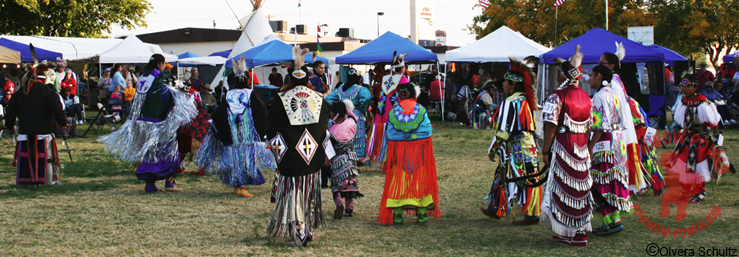History
Native American Powwow History
The word powwow in itself is from an Indian word that has been Anglicized. It is derived from the Algonquian term “pau-wau” or “pauau”, which referred to a gathering of medicine men and/or spiritual leaders. “Pau-wauing” referred to a religious ceremony, usually one of curing (Braine 1995:10). In the 1800’s the European explorers observing these religious gatherings and dances mispronounced the word as powwow. Non-Indians began to use the term to describe nearly any gathering of Native people they experienced and eventually, Indians themselves began using the term. As more Indians learned English, the more “powwow” became the accepted standard for both Indian and non-Indian people (Roberts 1992:12).
In Through Indian Eyes, published by Reader’s Digest (1995:387), it is stated that the powwow has roots in a Pawnee religious ceremony that was practiced early in the 19th century and that it was adopted by the Omaha and other tribes who then added speechmaking, gift giving and the feast. Several other sources, including the Powwow 1996 Calendar (1995:7) state that the original Powwow dances were held by elite warrior societies, also referred to as Grass Dancers.
According to Boye Ladd, Winnebago Fancy dancer, “The powwow dance goes back to the Omaha to a period about four hundred years ago. Today there are a lot of societies, especially in Dakotas, who still refer to the “Omaha Dances.” Down in Oklahoma there are societies evolved around warriors. The Hethuska societies, the stealthtakers. The Red Feather societies, the Kit Fox, the Dog Soldiers, all these societies evolve around warriors and what they have done in battle. Eagle feathers worn in these societies indicate coup that has been counted by brave deeds in battle. These ways still affect the powwow. An old story that goes back to a great-great-great-grandfather says that powwow dancing originated from four Omaha brothers who were warriors. They had returned from an expedition and performed a war dance in celebration of their success. This was way before the coming of the white man. They were not necessarily celebrating the taking of a life but pride in their good medicine. The dance they performed was a celebration of their good fortune as members of a family, a society, a clan and a tribe. It was a dance based in pride. We still see that pride today (Roberts 1992:17).”
The history of the powwow is somewhat vague. There is no definite record of exactly when the first powwow occurred. However, there are records and accounts of the powwow event going back as far as 100 years or more. Because in the 1890’s traditional Indian dances were illegal under the Bureau of Indian Affairs, it is difficult to establish definite beginnings of the powwow celebrations (Arlee 1998:4).
There is evidence that shows an attempt to hold a 4th of July Powwow in 1891. This was in Arlee, Montana on the Flathead Indian Reservation. It was a difficult argument for the BIA to say it would be illegal to celebrate this particular holiday; Indian police and Indian Agent Ronan used the threat of the US Army to break up the event (Arlee 1998:4).



